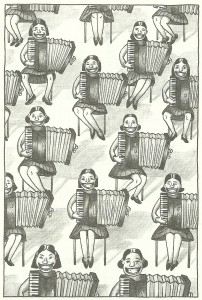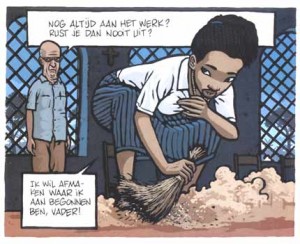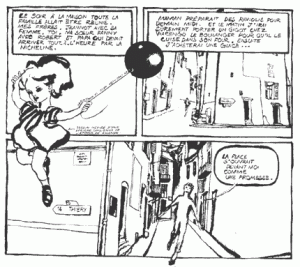My most recent post on Lefèvre’s and Guibert’s The Photographer received some insightful, but contentious, comments that I haven’t had a chance to respond to. And since I don’t have much else to post about at the moment (copies of Chloé Cruchaudet’s Mauvais Genre and Rutu Modan’s The Property are both in the mail), I will respond belatedly to these comments, which came from Noah and Suat, here in the form of a post.
Didier Lefèvre, Le Photographe
Noah’s comment:
I think there’s in general a question about whether empathy in these situations is helpful or useful. I think Suat wrote about this recently; engaging the West’s attention/sympathy isn’t always such a great thing for people experiencing war or human rights violations. Sometimes having us pay attention or having us put ourselves in your place is really dangerous/bad. (I think in general the Middle East probably wishes we’d stop paying attention to them, for example.) So, I guess I wonder whether the combination of photography/comics really changes the ethical calculus all that much. Obviously, failing to help a little girl in front of you is pretty repulsive, but framing the issue in terms of “if you don’t help you’re repulsive” — is that accurate? Or does art’s tendency to make geopolitical issues into a personal “you-must-help!” actually increase our tendency to try to solve other people’s problems by dropping bombs on them?
Probably the biggest thing we could do to help people in need throughout the world is (a) open our borders, and (b) end our crop subsidies. Neither of those really have much to do with representing the suffering of others in comics or photographs…which I agree raises really uncomfortable ethical questions.
Suat’s piece on the Walking Dead does make a powerful argument along these lines and I agree completely that humanitarian aid projects often hide pernicious forms of cultural and economic imperialism, whether you’re talking about immediately harmful cases such as US evangelicals driving hate legislation in Uganda or, more subtly, the way in which humanitarian aid from NGOs in post-conflict states like Sudan and Liberia has eroded their sovereignty by creating economic and political dependency. And certainly much of the funding for these humanitarian aid projects is generated through photography, video, copywriting, and art that aim to draw sympathy from their Western donors. So it is actually important, even necessary, that we be suspicious of cartoonists and photographers such as Lefèvre and Guibert (and while we’re at it, why not add Guy de Lisle, Joe Sacco, and company, to the list?) who deal in ethnographically oriented representations that seek an empathetic response from their readerships. But I don’t think the fact that discourses of humanitarian empathy are co-opted by American imperialist politics should lead us to dismiss or abandon artistic projects that elicit empathy towards those who suffer in faraway places. If anything, it should be the opposite.
However, it also doesn’t excuse artists from being uninformed about the perverse global circuits of “empathetic” Western cultural imperialism in which their work will inevitably find itself complicit. And so I guess another way of saying this is that what I meant by “ethical response” is very different from an impulse to simply donate or volunteer at, say, Red Cross or Doctors Without Borders. I mean it in a more absolute sense, I suppose. A fully ethical response would involve exactly the kind of delicate critical concern that Noah’s comment demanded. Of course, one can only fail in the face of such an absolute demand but this shouldn’t stop people from working towards it. I also agree completely with Noah’s point that opening borders and ending crop subsidies (or de-commodifying food) would make a more meaningful impact on people in need throughout the world. But the world of representation and the world of “ethical action” are always caught in a dialectic with one another, so we shouldn’t pretend that they can be thought of separately.
Guy Delisle, Pyongyang
Suat’s response to Noah’s comment:
Scott McCloud’s assertions about the iconicity of simple cartoon drawings are one of his more lasting contributions arising from Understanding Comics but I would also say that they are quite unprovable (how many things are in art?). In fact, from my point of view, the idea is anecdotally false or at least constitutes only a small part of the equation. For example, I found Persepolis thoroughly unmoving but found the Iranian movie, A Separation, considerably more humanistic and emotionally engaging. At least part of this is down to Satrapi’s poor cartooning skills. The idea that readers give life to stripped down iconic forms is nice but fanciful.
Similarly, Noah will be glad to hear that Lefevere and Guibert’s War Photographer stands very little chance of engaging anyone’s empathy. It’s been a few years since I read it but the lasting impression I have of it is my sheer irritation at the reading experience. For one, Guibert goes out of his way to make Lefevere a thoroughly unlikable person especially in the second part of the comic. More importantly, as is made clear in your article, the comic is entirely obsessed with his work as a photographer. It’s very much a “look at me” kind of comic. It has very little time for the people being photographed and one would be better served reading a book on the subject. I think this may be a subset of the self-centeredness elaborated on at length later in the comic.
I do agree that Lefèvre is almost as unlikable as Kevin Carter. But the narrative does insist on outlining a process of self-mortification and eventual transformation, which makes him, at the very least, forgivable. More importantly, I wasn’t trying to argue that Lefèvre is a sympathetic character. I think of him rather as a kind of focal point for the reader’s empathy towards the Afghani war wounded during the Soviet War. I might go as far as to say that it is somehow Lefèvre’s failure to be a good person that opens up a space for the reader’s empathy towards the latter’s photographic subjects. (And of course, the depiction and thematization of this failure is only possible through the addition of Guibert’s drawn panels).
Jean-Philippe Stassen, Deogratias
As for iconicity, I don’t know how to defend my use of the term other than by calling on my own reading experience, which may not be generalizable. I do however believe that a correlation between iconicity and reader empathy might be proven through some sort of psychological experiment. Reader empathy has already been the subject of psychological experimentation, experimental designs are already in place, and it wouldn’t be too hard to add “iconicity” to the mix of variables, so why not? But I also don’t think iconicity is the only mechanism through which readers give life to drawn figures in comics and I worry that I may have sounded as if that’s what I think by opposing photographic realism and cartoon iconicity in such stark terms. And I certainly don’t think that iconicity is necessarily a defining characteristic of comics. Some of the most moving graphic novels I’ve read are those of Edmond Baudoin, which are more painterly than iconic. Let me add that my interest in these questions comes less from the angle of formal definitions concerning the nature of the medium than from the angle of empathetic reading. I’m interested in how it is that artists engage the empathy, and to a further extent, the ethical responsibility, of their readers. So I will need to reframe the question to reflect that better.
Edmond Baudoin, Éloge de la poussière





Love this continuing thread on empathy!
This comment is not fully researched and only supported by a quick rereading of Chapter 2 of “Understanding Comics.” Nonetheless, I think it is important to note that McCloud does not use the word “empathy” when talking about the power of inconicity in comics. The concepts he does deploy are similar, but they focus on what he calls our psychological involvement with cartoony images, who they seem to pulse with life and do not have a static, solid nature of their own. The idea is that the vacuous (or evacuated) nature of icons “suck us in.” Or alternately, objects and images more easily become extensions of our sense of self, body, or mind.
The argument is not really about “feeling the feelings” of others or putting yourself in their shoes. It is an argument about how, phenomenologically, our interaction with cartoon images bring them “to life,” animate them. It is as much a description of volition and movement as it a statement about how comics can “move” us.
In this way, one can avoid the more extreme statements made on behalf of iconicity. I’m sure, for example, that McCloud would not deny that photographs or film have a much greater power of eliciting or creating empathy than cartoons. Similarly, our interaction and “identification” with cartoons often does not translate into anything resembling empathic engagement. (Think of how enjoyable cartoon violence is, as opposed to realistic violence.)
Empathy is conceptually connected to the language McCloud is using, but it has little to do with the phenomenon he is describing — an theory of phenomenological interaction, which allows objects that seem to have little in common with things we see in the “real” world nonetheless achieve some sort of secondhand liveliness.
In short, I think he avoids the word “empathy” because he’s not talking about empathy, at least as we commonly use the term.
Then again, there’s this.
But McCloud IS talking about “identification,” and there are quite a few assumptions about what readers may seek in comments. I am more likely to pick up a comic with an African American main character because I really struggle to find those representations, whereas other readers are less likely to do that. The presumption that some characters are already white, or male, or in some way representative of the reader runs through out representation.
In addition, I would say that while empathy and sympathy are–as many scholars have noted–problematic grounds for producing social change, we would be hard pressed to find social movements that did not use a suffering body as the grounds for mobilizing political action.
For all his fuzziness, McCloud seems to be talking about a more fundamental form of “identification” than the one you are decribing, Rebecca.
In my opinion, it’s a bit closer to what some schools of film theory called “primary identification” — the deep subconscious identification of the film viewer with the “gaze” of the camera (and all its power). It is an identification built into a certain act and structure of viewing. (This is what McCloud means, I think, when he calls comics a way of seeing.)
McCloud is talking much less about “secondary identification” — the ways in which we, as particular types of readers or viewers, identify with the protagonist, with particular types of characters, etc. Questions of empathy and sympathy seem to belong to this second category, just like the forms of readerly identification Rebecca describes.
I am not saying that comics do not or cannot engage a reader’s empathy. But it seems to be a different process from what McCloud is trying to capture with his analysis of iconicity.
[Note: other critics have made his jump from iconicity and identification to empathy. (Perhaps McCloud did it himself, in other contexts.) In his monograph on Chris Ware, for example, Dan Raeburn makes the leap at full speed, saying that a reader is more likely to empathize with this image of a sad cat than this one or, tough in cheek, this one.
Thank you Peter and Rebecca for your comments. I realize that there is some danger in making a claim that valorizes iconicity (as a kind of universal) and identification/empathy, since it is also this mechanism that produces the assumed white male reader Rebecca describes. But my argument, perhaps still poorly articulated, is that the identification made possible by cartoon iconicity (or maybe I should find another term, because I don’t want this to become some kind of overblown exegetical worship of McCloud’s thought) might make it possible to overcome the paralyzed response to the suffering of others that Sontag laments in her critique of wartime photographic journalism.
As a formalist at heart, I do see the critical value of maintaining the distinction between primary and secondary identification. But aren’t there film critics who also view even primary identification as culturally marked and gendered (Mulvey on the male gaze, etc.)? If that’s the case then it seems possible to argue that primary identification is always somehow responsible for the secondary identifications that a film or comic might elicit. And this might be another way of saying that cartoon iconicity can reproduce a version of the assumed white male reader (analogous to the male gaze in film) but it can also produce other identifications or better, in the right hands, disidentifications, in the sense that Muñoz uses the term, a process that “scrambles and reconstructs encoded messages [and] exposes the universalizing and exclusionary aspects of the message and recircuits it to account for/include/empower minorities identities and identifications” (Muñoz, Disidentifications)